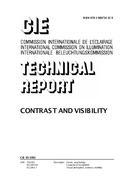Click here to purchase
The purpose of the present report is a study of literature related to analytical visual performance models and a discussion of various approaches with respect to a further development of a CIE contrast metric of visibility. It has been shown that many developments have taken place during the last 10 or 15 years which permit a much improved understanding of the multiparametric interactions in visual performance thresholds and in capability of predicting them.
The publication presents the concept of visibility lobes per glimpse which reveals a basis for evaluation of visual tasks and lighting conditions. An analytical function is discussed which includes foveal and extrafoveal vision, target-background interference, and information load.
A critical point is the appropriate definition of contrast. It should be distinguished, for example, between inner and outer contrast. Furthermore, different filtering channels have to be taken into account if contrast sensitivity is measured. Contrast sensitivity as a function of spatial frequency must be determined for the prediction of detection and discrimination capabilities of observers. Priority of further work should be given to the investigation of visibility lobes as a function of target and background structures.
The report is divided into three parts. The first part is an introduction where the CIE contrast metric of visibility is discussed and some recent approaches are listed that can be used to characterize visual performance for near threshold and suprathreshold stimuli.
The second part starts with an attempt to survey some important properties of the modular transfer function of the human visual system. After that, some models of early visual processing are considered which are based on results from psychophysics and neurophysiology and which might have consequences for further developments of a contrast metric of visibility.
The third part is essentially a discussion where the achievements and limitations of the various approaches are listed.
The report contains 52 pages, with 19 figures.
Product Details
- Published:
- 01/01/1992
- ISBN(s):
- 9783900734329
- Number of Pages:
- 56
- File Size:
- 1 file , 830 KB
